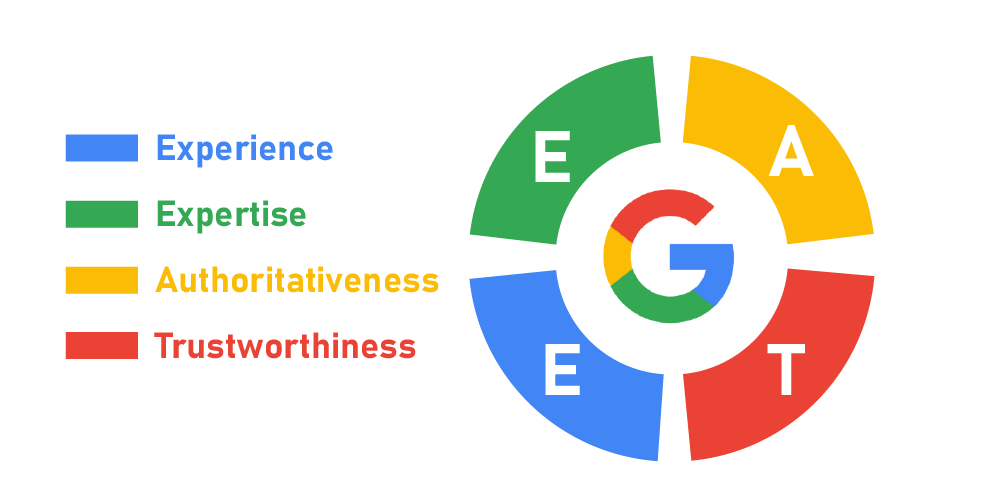Transit audiences are undoubtedly unique. Riders are often searching for "bus schedules {cityname}" and expecting to be delivered to relevant content. However, because some transit agencies are just pages within a city government site, agencies lose the ability to customize their own site based on internal and external stakeholder needs.
Here, we’ll explore how transit authorities can get back in the driver’s seat and use their websites to advance community mobility, increase visibility, and reduce friction for riders.
Search Engines Need to Know What Your Site is All About
Google’s algorithms for delivering relevant search results continue to get increasingly sophisticated. Recently, Google announced adding an extra “E” to their famous E-A-T model (now E-E-A-T), which adds experience to the expertise, authoritativeness, and trustworthiness framework followed by search engine optimizers the world over.
Each of these key tenets is critical to how a site is ranked. Remember, Google’s entire existence revolves around providing searchers with the most relevant results possible. Crawling your website’s pages, Google can ascertain what the site is about and help steer prospective riders and other stakeholders directly to the appropriate page on your site. Seems simple, right? However, if your content is buried on a clunky municipal website or lacking E-E-A-T, your message may not be being broadcasted as loud and clear as you might think.

Your Audience Includes Far More than Riders
Having a dedicated site means catering your content and communications directly to your audience. The audience for modern transit agencies go far beyond just riders.. There are outside vendors looking for bidding opportunities, prospective job seekers wanting to apply, community stakeholders and many other interested parties who may never even ride your transit system.
Compare these segments with a general city resident visiting their municipality’s website and you see how vastly different they are. Different market segments require different communications strategies to reach them where they are. To do that effectively, you have to lean into the data, which is something most transit agencies simply don’t have access to or possess the knowledge and understanding of how to utilize the vast amounts of marketing engagement data.
A dedicated platform like our proprietary eTransit™ system allows agencies to capture and utilize the power of data to tailor communications for maximum effect. We connect the dots for you to let your data tell a story that helps your agency to make informed decisions.

Remain in Control of Your Transit Agency’s Marketing Presence
When an agency has control over their marketing presence, they are able to utilize their website as a key driver for advancing their mission. The opposite of which is when transit agency websites are conjoined within their municipal government’s site, which acts more like an informational billboard.
City government sites host a lot of content. There is generally information on everything from taxes to trash pickup and everything in between for all that’s needed to run a city. The issue is, these sites aren’t about attracting visitors and converting them as we do in digital marketing; rather they are informational resource sites. While there is nothing inherently wrong with simply putting up information, for a transit agency trying to reach key demographics or attract new riders, there is a wide disconnect in priorities.
Without the ability to tailor messaging to the right audience at the right time, transit agencies are unable to develop relationships with its various audience members. A “one-size-fits-all” approach rarely works in everyday life, nor does it work with transit agency websites. Customization based on each agency’s individual needs allows for maximum flexibility in marketing strategy.
Maintaining control over the site and its content also affords the opportunity to collect the audience’s contact information and other pertinent data. This action allows your team to speak to the audience directly with whatever marketing tactic is most advantageous for that specific demographic and communications platform.

What are Riders Searching For?
Keep in mind, most riders are popping in a quick Google/Bing search for “bus schedules near me” or something similar. That rider is expecting to be delivered right to your transit agency’s page where they can quickly find all the information they need in an accessible format.
It is imperative that agencies reduce friction and remove distractions for the audience. Oftentimes, if a rider finds themselves on a city government website, they will face virtually endless distractions. They’ll find links to other city departments, search bars that have nothing to do with transit, and ten years’ worth of capital improvement plans, among other things.
Consider the website. There are calls-to-action (CTAs), sidebars, footers, and more that all detract from the typically small transit sub-section on a city government website. Imagine if all of those CTAs and other elements were perfectly and naturally in tune with what a rider is most likely searching for. Focusing on user experience (UX) reduces friction by putting your team in your rider’s shoes, which can help turn a casual audience member into a passionate evangelist.

What eTransit Can Do For Your Transit Agency
Transit agencies, no doubt, can capitalize on the expertise of digital marketing agencies to propel their online presence, but they need a partner with niche experience with the day-to-day realities for transit authority staff. Turnover, siloization, budgets, politics, and more can create a minefield that mires project success, which is why Station Four created eTransit.
Station Four pioneered our all-in-one transit marketing platform just for the unique challenges transit authorities face. It creates a centralized dashboard for site content, procurement information, transport schedules, data capture, and so much more.
The platform takes an “audience-first” approach to help reduce barriers between audience members and the information/functionality they are seeking. It provides a centralized location that ensures all information is quickly accessible and critical user data is captured such that the agency is able to evolve and make better decisions going forward.
Get Started with Our Cutting-Edge Transit Marketing Platform
S4 created the sophisticated framework within eTransit to help transit agencies provide their critical community services more accessible to all users. From riders and job seekers to internal agency staff, eTransit provides a centralized dashboard to ensure that everyone has the information they need at their fingertips.
Schedule your free consultation with Station Four to discover how tools like our revolutionary eTransit platform can propel your transit agency into the modern era of digital marketing and communications.